Abstract
The gene for acetyl-CoA carboxylase, the rate-limiting enzyme in the biogenesis of long chain fatty acids, contains two promoter regions which control the generation of different forms of carboxylase mRNA. At least five different forms of carboxylase mRNA are generated by differential splicing of the two transcripts formed under the influence of two promoters. One of the two promoters is mainly responsible for the generation of a class of carboxylase mRNA species, pAU type, induced tissue specifically under lipogenic conditions; the other generates ACC mRNAs (FL-type) which are expressed under normal conditions but this expression is also stimulated under lipogenic conditions. In the present studies, we have characterized the promoter that is responsible for the FL-type of ACC mRNA. This promoter contains no TATA or CAAT boxes, but five G/C motifs whose sequences are typical of transcriptional factor Sp1 binding sites. However, the presence of these G/C motifs is not sufficient to drive the transcription of the gene under the control of this promoter. Expression of promoter activity requires three copies of 11 to 13mer enhancer elements which are located in the region upstream to the G/C motifs. The presence of such enhancer elements in a house-keeping gene is unusual, and provides a new example where an enhancer element occurs in the CpG island-type promoter of a house-keeping gene.
Full text
PDF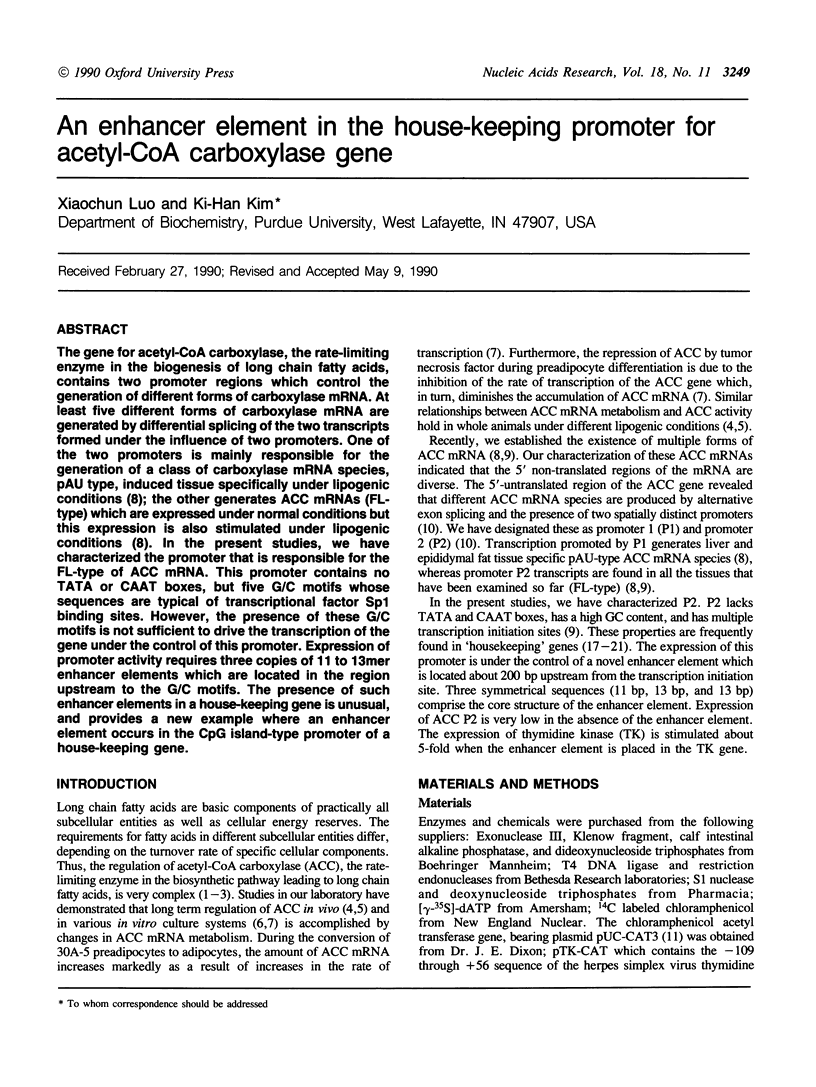
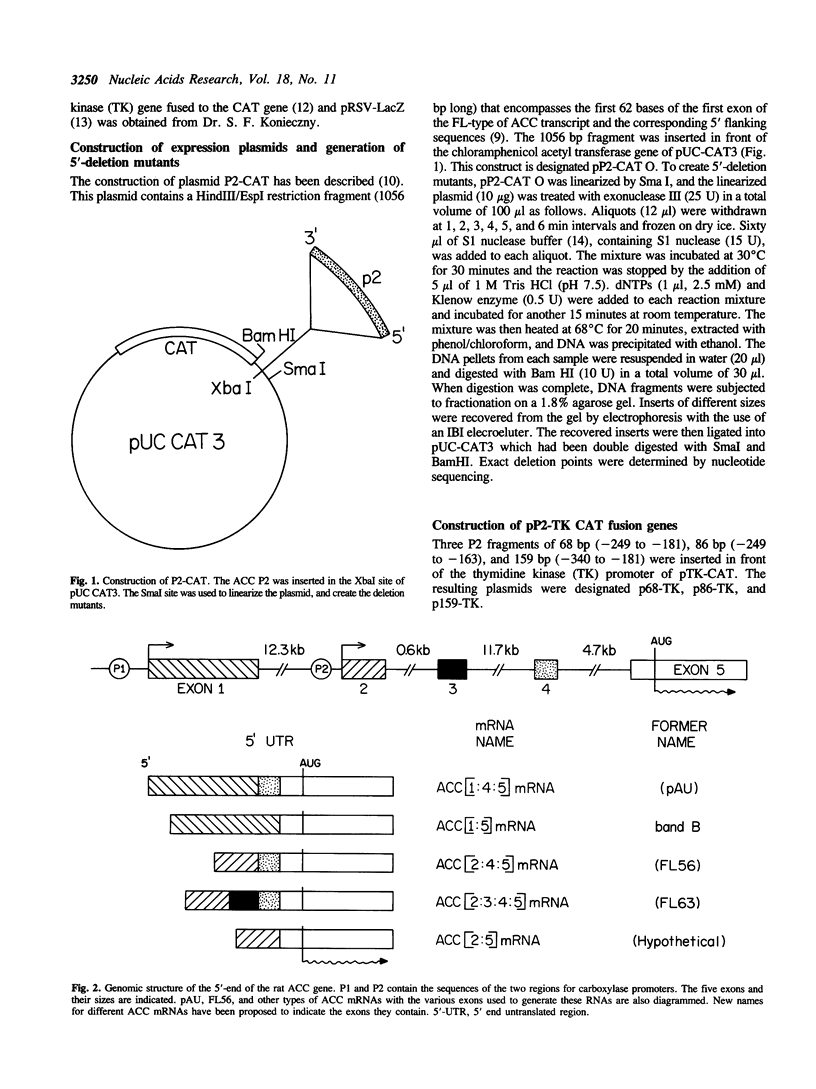
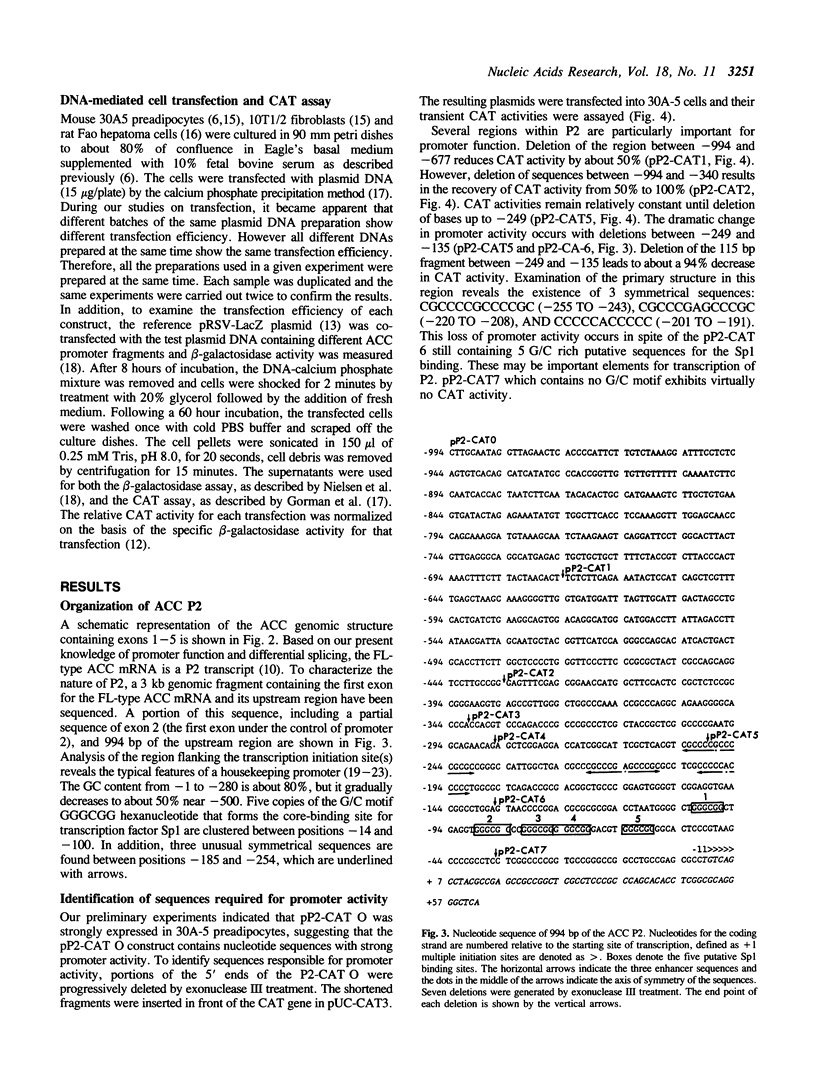
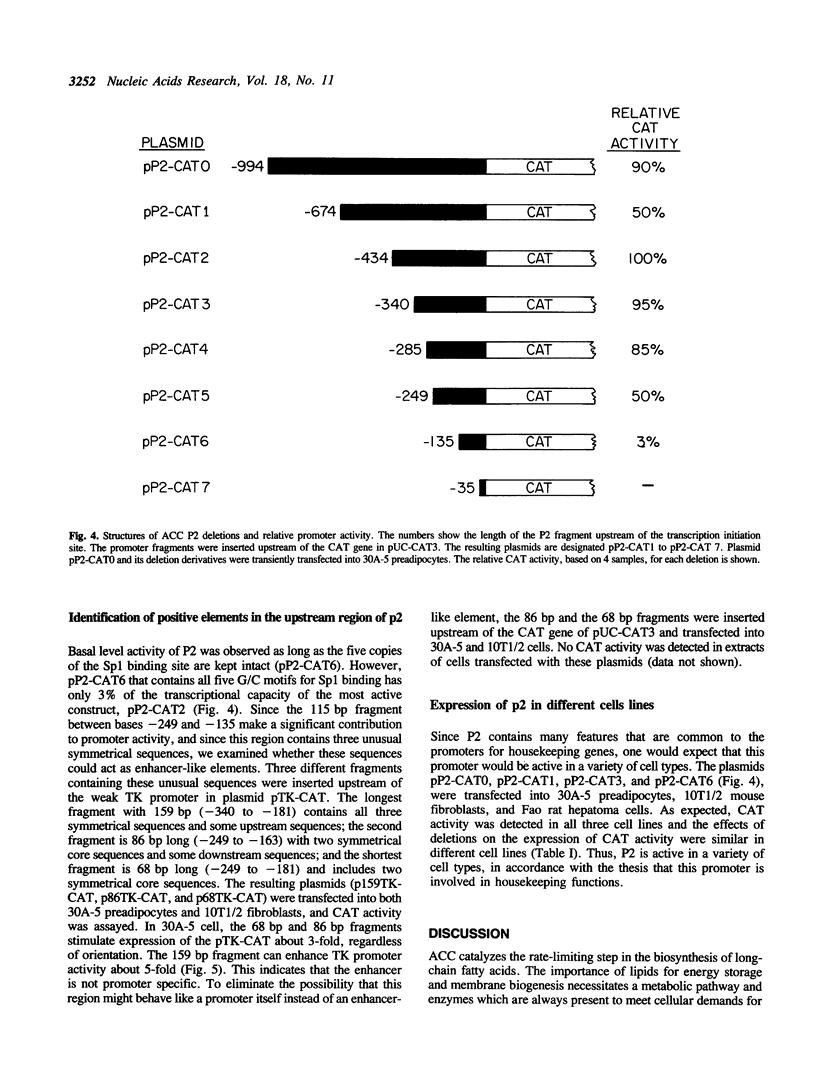
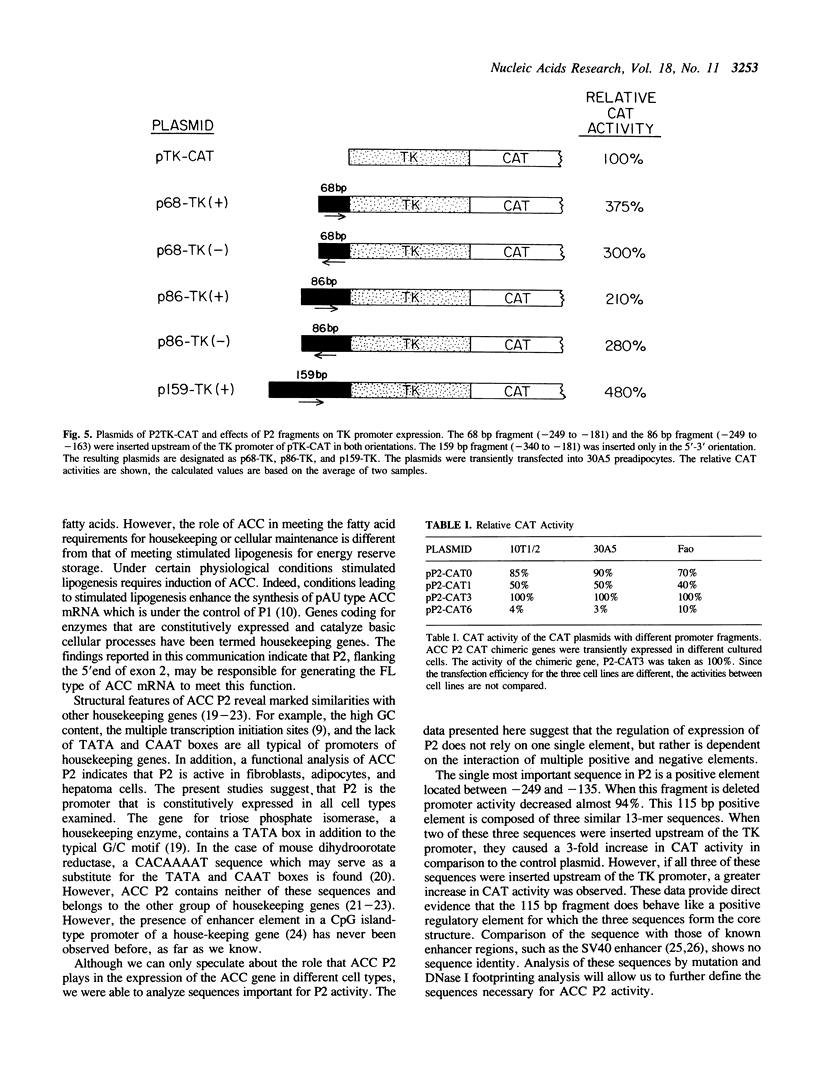
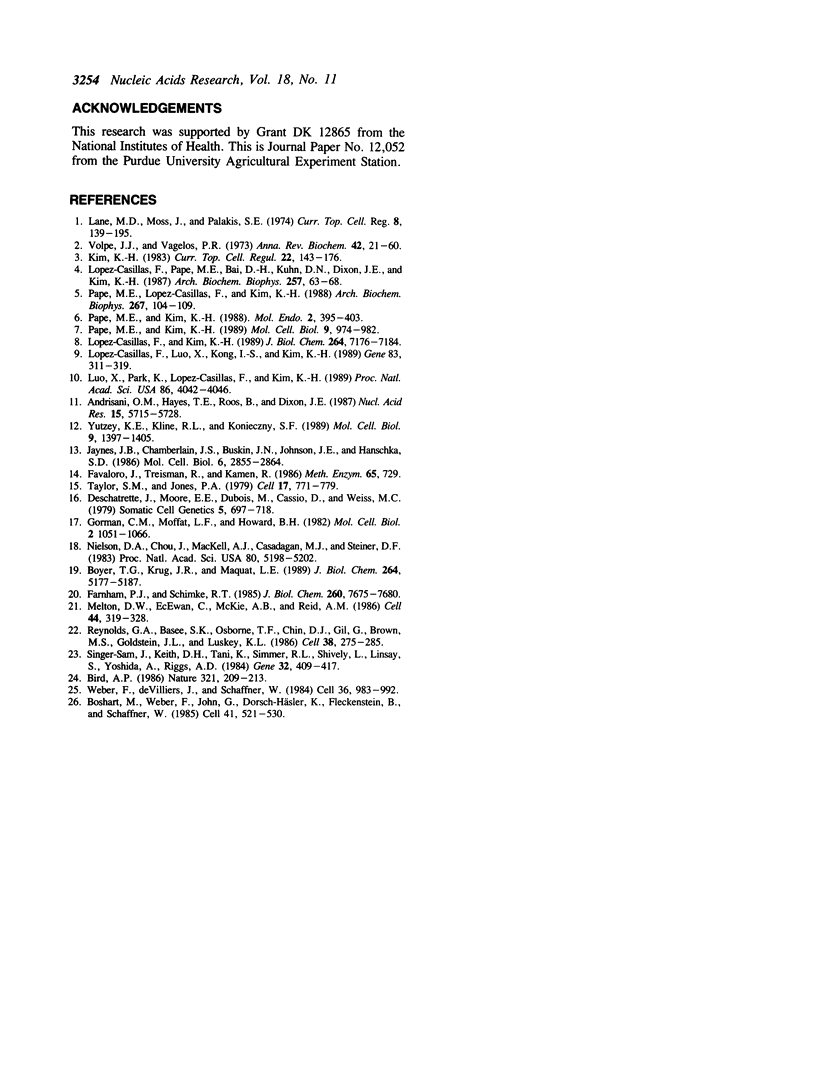
Selected References
These references are in PubMed. This may not be the complete list of references from this article.
- Andrisani O. M., Hayes T. E., Roos B., Dixon J. E. Identification of the promoter sequences involved in the cell specific expression of the rat somatostatin gene. Nucleic Acids Res. 1987 Jul 24;15(14):5715–5728. doi: 10.1093/nar/15.14.5715. [DOI] [PMC free article] [PubMed] [Google Scholar]
- Bird A. P. CpG-rich islands and the function of DNA methylation. Nature. 1986 May 15;321(6067):209–213. doi: 10.1038/321209a0. [DOI] [PubMed] [Google Scholar]
- Boshart M., Weber F., Jahn G., Dorsch-Häsler K., Fleckenstein B., Schaffner W. A very strong enhancer is located upstream of an immediate early gene of human cytomegalovirus. Cell. 1985 Jun;41(2):521–530. doi: 10.1016/s0092-8674(85)80025-8. [DOI] [PubMed] [Google Scholar]
- Boyer T. G., Krug J. R., Maquat L. E. Transcriptional regulatory sequences of the housekeeping gene for human triosephosphate isomerase. J Biol Chem. 1989 Mar 25;264(9):5177–5187. [PubMed] [Google Scholar]
- Deschatrette J., Moore E. E., Dubois M., Cassio D., Weiss M. C. Dedifferentiated variants of a rat hepatoma: analysis by cell hybridization. Somatic Cell Genet. 1979 Nov;5(6):697–718. doi: 10.1007/BF01542636. [DOI] [PubMed] [Google Scholar]
- Farnham P. J., Schimke R. T. Transcriptional regulation of mouse dihydrofolate reductase in the cell cycle. J Biol Chem. 1985 Jun 25;260(12):7675–7680. [PubMed] [Google Scholar]
- Gorman C. M., Moffat L. F., Howard B. H. Recombinant genomes which express chloramphenicol acetyltransferase in mammalian cells. Mol Cell Biol. 1982 Sep;2(9):1044–1051. doi: 10.1128/mcb.2.9.1044. [DOI] [PMC free article] [PubMed] [Google Scholar]
- Jaynes J. B., Chamberlain J. S., Buskin J. N., Johnson J. E., Hauschka S. D. Transcriptional regulation of the muscle creatine kinase gene and regulated expression in transfected mouse myoblasts. Mol Cell Biol. 1986 Aug;6(8):2855–2864. doi: 10.1128/mcb.6.8.2855. [DOI] [PMC free article] [PubMed] [Google Scholar]
- Kim K. H. Regulation of acetyl-CoA carboxylase. Curr Top Cell Regul. 1983;22:143–176. doi: 10.1016/b978-0-12-152822-5.50009-9. [DOI] [PubMed] [Google Scholar]
- Lane M. D., Moss J., Polakis S. E. Acetyl coenzyme A carboxylase. Curr Top Cell Regul. 1974;8(0):139–195. [PubMed] [Google Scholar]
- Luo X. C., Park K., Lopez-Casillas F., Kim K. H. Structural features of the acetyl-CoA carboxylase gene: mechanisms for the generation of mRNAs with 5' end heterogeneity. Proc Natl Acad Sci U S A. 1989 Jun;86(11):4042–4046. doi: 10.1073/pnas.86.11.4042. [DOI] [PMC free article] [PubMed] [Google Scholar]
- López-Casillas F., Kim K. H. Heterogeneity at the 5' end of rat acetyl-coenzyme A carboxylase mRNA. Lipogenic conditions enhance synthesis of a unique mRNA in liver. J Biol Chem. 1989 May 5;264(13):7176–7184. [PubMed] [Google Scholar]
- López-Casillas F., Luo X. C., Kong I. S., Kim K. H. Characterization of different forms of rat mammary gland acetyl-coenzyme A carboxylase mRNA: analysis of heterogeneity in the 5' end. Gene. 1989 Nov 30;83(2):311–319. doi: 10.1016/0378-1119(89)90117-0. [DOI] [PubMed] [Google Scholar]
- López-Casillas F., Pape M. E., Bai D. H., Kuhn D. N., Dixon J. E., Kim K. H. Preparation of functional acetyl-CoA carboxylase mRNA from rat mammary gland. Arch Biochem Biophys. 1987 Aug 15;257(1):63–68. doi: 10.1016/0003-9861(87)90543-1. [DOI] [PubMed] [Google Scholar]
- Melton D. W., McEwan C., McKie A. B., Reid A. M. Expression of the mouse HPRT gene: deletional analysis of the promoter region of an X-chromosome linked housekeeping gene. Cell. 1986 Jan 31;44(2):319–328. doi: 10.1016/0092-8674(86)90766-x. [DOI] [PubMed] [Google Scholar]
- Nielsen D. A., Chou J., MacKrell A. J., Casadaban M. J., Steiner D. F. Expression of a preproinsulin-beta-galactosidase gene fusion in mammalian cells. Proc Natl Acad Sci U S A. 1983 Sep;80(17):5198–5202. doi: 10.1073/pnas.80.17.5198. [DOI] [PMC free article] [PubMed] [Google Scholar]
- Pape M. E., Kim K. H. Effect of tumor necrosis factor on acetyl-coenzyme A carboxylase gene expression and preadipocyte differentiation. Mol Endocrinol. 1988 May;2(5):395–403. doi: 10.1210/mend-2-5-395. [DOI] [PubMed] [Google Scholar]
- Pape M. E., Kim K. H. Transcriptional regulation of acetyl coenzyme A carboxylase gene expression by tumor necrosis factor in 30A-5 preadipocytes. Mol Cell Biol. 1989 Mar;9(3):974–982. doi: 10.1128/mcb.9.3.974. [DOI] [PMC free article] [PubMed] [Google Scholar]
- Pape M. E., Lopez-Casillas F., Kim K. H. Physiological regulation of acetyl-CoA carboxylase gene expression: effects of diet, diabetes, and lactation on acetyl-CoA carboxylase mRNA. Arch Biochem Biophys. 1988 Nov 15;267(1):104–109. doi: 10.1016/0003-9861(88)90013-6. [DOI] [PubMed] [Google Scholar]
- Reynolds G. A., Basu S. K., Osborne T. F., Chin D. J., Gil G., Brown M. S., Goldstein J. L., Luskey K. L. HMG CoA reductase: a negatively regulated gene with unusual promoter and 5' untranslated regions. Cell. 1984 Aug;38(1):275–285. doi: 10.1016/0092-8674(84)90549-x. [DOI] [PubMed] [Google Scholar]
- Singer-Sam J., Keith D. H., Tani K., Simmer R. L., Shively L., Lindsay S., Yoshida A., Riggs A. D. Sequence of the promoter region of the gene for human X-linked 3-phosphoglycerate kinase. Gene. 1984 Dec;32(3):409–417. doi: 10.1016/0378-1119(84)90016-7. [DOI] [PubMed] [Google Scholar]
- Taylor S. M., Jones P. A. Multiple new phenotypes induced in 10T1/2 and 3T3 cells treated with 5-azacytidine. Cell. 1979 Aug;17(4):771–779. doi: 10.1016/0092-8674(79)90317-9. [DOI] [PubMed] [Google Scholar]
- Volpe J. J., Vagelos P. R. Saturated fatty acid biosynthesis and its regulation. Annu Rev Biochem. 1973;42:21–60. doi: 10.1146/annurev.bi.42.070173.000321. [DOI] [PubMed] [Google Scholar]
- Weber F., de Villiers J., Schaffner W. An SV40 "enhancer trap" incorporates exogenous enhancers or generates enhancers from its own sequences. Cell. 1984 Apr;36(4):983–992. doi: 10.1016/0092-8674(84)90048-5. [DOI] [PubMed] [Google Scholar]
- Yutzey K. E., Kline R. L., Konieczny S. F. An internal regulatory element controls troponin I gene expression. Mol Cell Biol. 1989 Apr;9(4):1397–1405. doi: 10.1128/mcb.9.4.1397. [DOI] [PMC free article] [PubMed] [Google Scholar]


